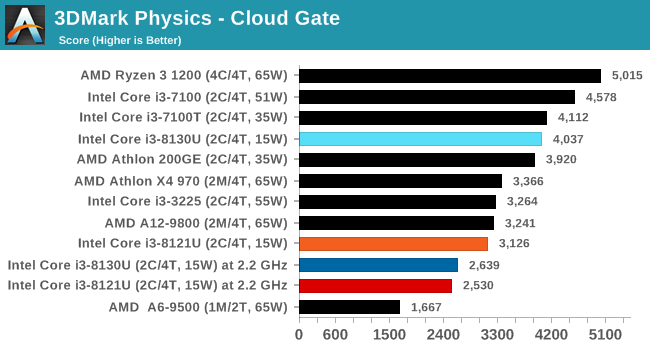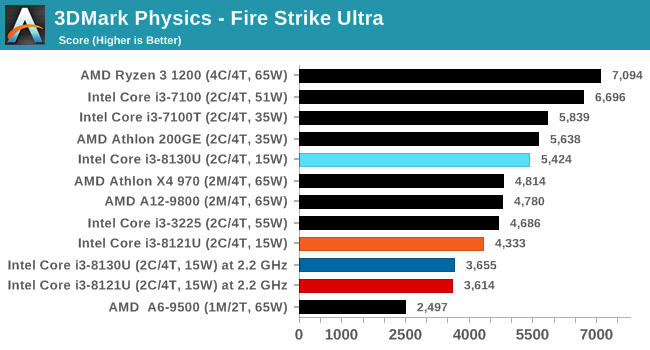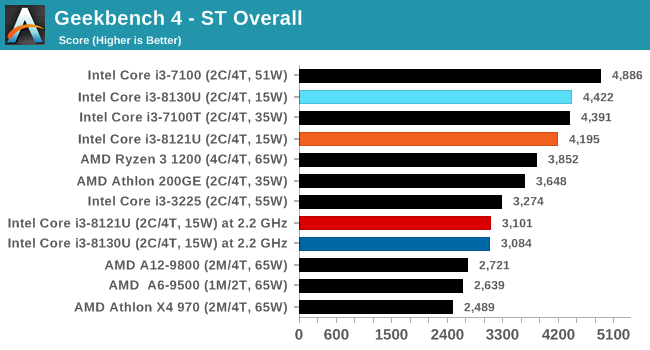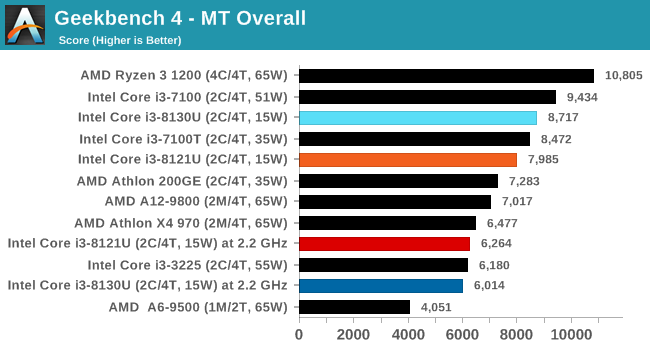Intel's 10nm Cannon Lake and Core i3-8121U Deep Dive Review
by Ian Cutress on January 25, 2019 10:30 AM ESTStock CPU Performance: Office Tests
The Office test suite is designed to focus around more industry standard tests that focus on office workflows, system meetings, some synthetics, but we also bundle compiler performance in with this section. For users that have to evaluate hardware in general, these are usually the benchmarks that most consider.
All of our benchmark results can also be found in our benchmark engine, Bench.
3DMark Physics: In-Game Physics Compute
Alongside PCMark is 3DMark, Futuremark’s (UL’s) gaming test suite. Each gaming tests consists of one or two GPU heavy scenes, along with a physics test that is indicative of when the test was written and the platform it is aimed at. The main overriding tests, in order of complexity, are Ice Storm, Cloud Gate, Sky Diver, Fire Strike, and Time Spy.
Some of the subtests offer variants, such as Ice Storm Unlimited, which is aimed at mobile platforms with an off-screen rendering, or Fire Strike Ultra which is aimed at high-end 4K systems with lots of the added features turned on. Time Spy also currently has an AVX-512 mode (which we may be using in the future).
For our tests, we report in Bench the results from every physics test, but for the sake of the review we keep it to the most demanding of each scene: Ice Storm Unlimited, Cloud Gate, Sky Diver, Fire Strike Ultra, and Time Spy.





In all tests, at fixed frequency, the processors act identical, however at stock frequencies that Kaby Lake chip just has more headroom to push.
GeekBench4: Synthetics
A common tool for cross-platform testing between mobile, PC, and Mac, GeekBench 4 is an ultimate exercise in synthetic testing across a range of algorithms looking for peak throughput. Tests include encryption, compression, fast Fourier transform, memory operations, n-body physics, matrix operations, histogram manipulation, and HTML parsing.
I’m including this test due to popular demand, although the results do come across as overly synthetic, and a lot of users often put a lot of weight behind the test due to the fact that it is compiled across different platforms (although with different compilers).
We record the main subtest scores (Crypto, Integer, Floating Point, Memory) in our benchmark database, but for the review we post the overall single and multi-threaded results.












129 Comments
View All Comments
jjj - Friday, January 25, 2019 - link
Bored with laptops, want a large foldable phone with a projected keyboard so i can forget about these bulky heavy things. Ok, fair enough, glasses are way better but those will take a while longer.eastcoast_pete - Friday, January 25, 2019 - link
@Ian: Thanks for the deep dive, and giving the references for background! One comment, three questions (they're related): In addition to being very (overly) ambitious with the 10 nm process, I was particularly struck by the "fused-off integrated graphics" and how Intel's current 10 nm process apparently just won't play nice with the demands in a GPU setting. Question: Any information or rumors on whether that contributed to AMD going the chiplet route for Ryzen going forward? In addition to improving yields, that also allows for heterogeneous manufacturing nodes on the same final chip, so that can get around that problem. Finally, any signs that Intel may go down that road in its upcoming mainstream chips? Any updates on what node they will make their much-announced dGPUs on? Probably won't be this or a related 10 nm process.Lastly, and maybe you and Andrei can weigh in on that: TSMC's (different) 7 nm process seems to work okay for the (smaller) different "iGPUs" in Apple's 12/12x, Huawei's newest Kirin and the new Snapdragon. Any insight/speculation which steps of Intel's 10 nm process cause the apparent incompatibility with GPU usage scenarios?
Thanks!
Rudde - Saturday, January 26, 2019 - link
AMD has lauched huge 7nm desktop graphics cards (2 server and Radeon VII). AMD does not seem to have any problems making gpus on TSMC 7nm.eastcoast_pete - Sunday, January 27, 2019 - link
That's why I asked about the apparent incompatibility of GPU-type dies with Intel's 10 nm process. Isn't it curious that this seems to be the Achilles heel of Intel's process? I wonder if their future chips with " iGPU" will use a chiplet-type approach, with the CPU parts in 10 nm, and the GPU in 14 nm++++ or however many + generations it'd be on. The other big question is what process their upcoming high-end dGPU will be in Unless, Intel let's TSMC make that for them, too.velanapontinha - Friday, January 25, 2019 - link
Every time I read Kaby G I'm instantly stormed by a Kenny G theme stuck in my head, and it ruins the rest of my day.Please stop.
skis4hire - Friday, January 25, 2019 - link
"Fast forward several months later, to May 2018, and we still had not heard anything from Intel."Anton covered their statement in April, where they indicated they weren't shipping volume 10nm until sometime in 2019, and that they would instead release another 14nm product, whiskey lake, in the interim.
https://www.anandtech.com/show/12693/intel-delays-...
Yorgos - Friday, January 25, 2019 - link
>AMD XXXXX (XM/XT, XXW)Thanks Ian for reminding us is every article, that we are reading a Purch media product, or a clueless editor.
Don't forget, 386 was o 0 core CPU.
No, it doesn't bother me as a reader, it bothers me as an engineer who designs and studies digital circuits. But hey you can't have it all, it's hard to find someone who is capable at running windows executables AND know his way in comp. arch..
Ryan Smith - Friday, January 25, 2019 - link
While I'm all for constructive feedback, I have to admit I'm not sure what we're meant to be taking from this.Could you please articulate in more detail what exactly is wrong with the article?
KateH - Saturday, January 26, 2019 - link
i interpreted it as,...
"I disagree with the distinction between 'modules' and 'cores' that is made when some journalistic endevours mention AMD's 'Construction' architecture microprocessors. I find the drawing of a line based on FPU counts inaccurate- disengenous even- given that historic microprocessors such as the renowned Intel 80386 did not feature an on-chip FPU at all, an omission that would under the definitions used by this journalist in this article cause the '386 to be described as having 'zero cores'. The philosophical exercise suggested by such a definition is, based upon my extensive experience in the industry of digital circuit design, repugnant to my sensibilities and in my opinion calls into question the journalistic integrity of this very publication!"
...
or something like that
(automatically translated from Internet Hooligan to American English, tap here to rate translation)
Ryan Smith - Saturday, January 26, 2019 - link
"tap here to rate translation"5/5 stars. Thank you!